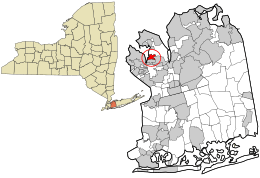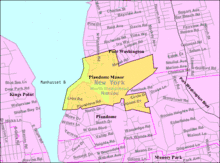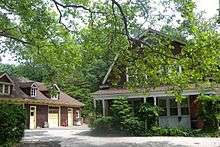Plandome Manor, New York
Plandome Manor is a village in Nassau County, New York in the United States. The population was 872 at the 2010 census.
Plandome Manor, New York | |
|---|---|
Village | |
| Incorporated Village of Plandome Manor | |
 Location in Nassau County and the state of New York. | |
 Plandome Manor, New York Location within the state of New York | |
| Coordinates: 40°48′54″N 73°41′57″W | |
| Country | United States |
| State | New York |
| County | Nassau |
| Government | |
| • Mayor | Barbara Donno |
| Area | |
| • Total | 0.51 sq mi (1.31 km2) |
| • Land | 0.48 sq mi (1.25 km2) |
| • Water | 0.02 sq mi (0.06 km2) |
| Elevation | 36 ft (11 m) |
| Population (2010) | |
| • Total | 872 |
| • Estimate (2019)[2] | 902 |
| • Density | 1,863.64/sq mi (720.02/km2) |
| Time zone | UTC−5 (Eastern (EST)) |
| • Summer (DST) | UTC−4 (EDT) |
| FIPS code | 36-58497 |
| GNIS feature ID | 0960670 |
| Website | plandomemanor |
The Incorporated Village of Plandome Manor is in the Town of North Hempstead. It is served by the Manhasset, New York school district.
History
The Inc. Village of Plandome Manor, incorporated in 1931, as well as the villages of Plandome and Plandome Heights to its south, derives its name from the Latin 'Planus Domus', meaning plain, or level home. The manor house of Matthias Nicoll who was an early mayor of New York City and among the first generation of the Nicoll family on Long Island, was a wood frame home built in the 1670s, and one of the first homesteads in this area of Cow Neck, the original name of the Manhasset/Port Washington Peninsula. The manor itself was torn down in 1998 and replaced with another estate.[3]
Author Frances H. Burnett, author of The Secret Garden, built her home, Fairseat, in Plandome Park in 1908, and lived there until her death in 1924. Her son, Vivian, and his wife Constance, had built a home nearby on Bayview Road after their marriage. Frances Burnett's nephew, publisher Archer P. Fahnestock moved into Fairseat after her death, but the home burned down leaving only the stucco carriage house and garden intact. In 1940, Fahnestock sold it to Leroy Grumman.
Geography

According to the United States Census Bureau, the village has a total area of 0.6 square miles (1.6 km2), of which, 0.5 square miles (1.3 km2) of it is land and 0.1 square miles (0.26 km2) of it (13.56%), including Leeds Pond in the northeastern part of the village, is water.


Demographics
| Historical population | |||
|---|---|---|---|
| Census | Pop. | %± | |
| 1940 | 262 | — | |
| 1950 | 323 | 23.3% | |
| 1960 | 705 | 118.3% | |
| 1970 | 835 | 18.4% | |
| 1980 | 883 | 5.7% | |
| 1990 | 790 | −10.5% | |
| 2000 | 838 | 6.1% | |
| 2010 | 872 | 4.1% | |
| Est. 2019 | 902 | [2] | 3.4% |
| U.S. Decennial Census[4] | |||
As of the census[5] of 2000, there were 838 people, 281 households, and 241 families residing in the village. The population density was 1,637.6 people per square mile (634.4/km2). There were 288 housing units at an average density of 562.8 per square mile (218.0/km2). The racial makeup of the village was 92.12% White, 0.36% African American, 5.49% Asian, 0.84% from other races, and 1.19% from two or more races. Hispanic or Latino of any race were 2.27% of the population.
There were 281 households, out of which 42.3% had children under the age of 18 living with them, 80.4% were married couples living together, 3.2% had a female householder with no husband present, and 13.9% were non-families. Of all households 12.8% were made up of individuals, and 8.9% had someone living alone who was 65 years of age or older. The average household size was 2.98 and the average family size was 3.24.
In the village, the population was spread out, with 28.2% under the age of 18, 4.5% from 18 to 24, 23.4% from 25 to 44, 26.8% from 45 to 64, and 17.1% who were 65 years of age or older. The median age was 42 years. For every 100 females, there were 91.8 males. For every 100 females age 18 and over, there were 90.5 males.
The median income for a household in the village was $176,959, and the median income for a family was $193,496. Males had a median income of $100,000 versus $69,583 for females. The per capita income for the village was $77,276. About 2.0% of families and 2.2% of the population were below the poverty line, including 2.1% of those under age 18 and none of those age 65 or over.
Notable residents (past and present)
- Ray Bolger (1904–1987), actor (The Wizard of Oz)
- Frank H. Brunell (1852–1933), baseball executive, sports writer, founder of the Daily Racing Form
- Frances Hodgson Burnett (1849–1924), playwright, author, wrote The Secret Garden while living in Plandome Manor
- Archer P. Fahnestock (1873–1939), journalist, manufacturer, inventor, President: Fahnestock Electric Co.
- Raoul H. Fleischmann (1885–1969), an heir of Fleischmann's Baking Products, co-founder and chairman of the board of The New Yorker magazine
- Leroy Grumman (1895–1982), co-founder, Grumman Aerospace Corp.
- Benjamin Henry (B.H.) Inness-Brown (1878–1957), attorney, first mayor of Plandome Manor, editor of the Harvard Law Review
- Hugh Alwyn Inness-Brown, Sr. (1892-1972), New York publisher and journalist, founder of Trade Publications, Inc.
- Virginia Portia Royall Inness-Brown (1901–1990), proponent of the arts, socialite
- Warner M. Leeds (1868–1925), president, American Tin-Plate Company
- Martin W. Littleton (1872–1934), Brooklyn Congressman, D.A., and Borough President, attorney for Harry Thaw's second trial for murder of Stanford White
- Dr. Samuel Latham Mitchill (1764–1830), U.S. Senator, physician, professor at Columbia College
- William Fellowes Morgan, Jr. (1889–1977), commissioner of the Dept. of Markets of the City of New York
- Matthias Nicoll (1630–1687), Mayor of New York 1672–1674, Speaker of the first Colonial Assembly
- Ellis L. Phillips (1874–1959), engineer, co-founder and first president, Long Island Lighting Company
- John Hay Whitney (1904–1982), U.S. Ambassador, publisher, horse breeder, socialite
References
- "2019 U.S. Gazetteer Files". United States Census Bureau. Retrieved July 27, 2020.
- "Population and Housing Unit Estimates". United States Census Bureau. May 24, 2020. Retrieved May 27, 2020.
- Endangered: Historic Preservation - New York Times - June 12, 2005
- "Census of Population and Housing". Census.gov. Retrieved June 4, 2015.
- "U.S. Census website". United States Census Bureau. Retrieved 2008-01-31.